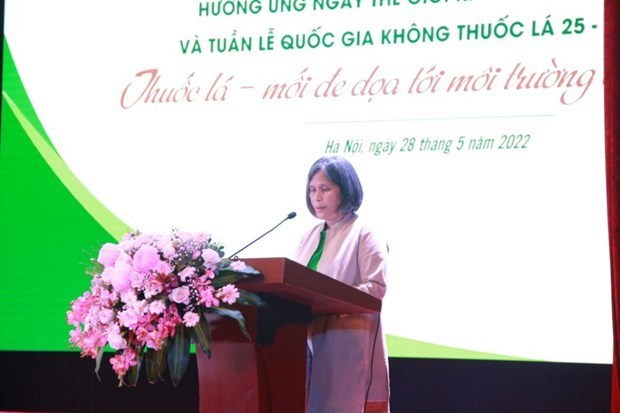 Opinion
Opinion

Dr. Socorro Escalante, Acting WHO Representative in Việt Nam, spoke to the Vietnam News Agency on the impact of monkeypox and the risk of an outbreak in Asia

|
| Dr. Socorro Escalante, Acting WHO Representative in Việt Nam. —VNA/VNS Photo |
Dr. Socorro Escalante, Acting WHO Representative in Việt Nam, spoke to the Vietnam News Agency on the impact of monkeypox and the risk of an outbreak in Asia
Could you please tell us what are the causes of monkeypox and how does it affect humans?
Monkeypox is a viral zoonotic disease, meaning that it is transmitted from infected animals to humans.
Monkeypox can spread to people when they come into physical contact with an infected animal. Monkeypox is commonly found in central and west Africa where there are tropical rainforests and where animals that may carry the virus typically live.
Human-to-human transmission can occur via face-to-face exposure, direct physical contact, including sexual contact, or contact with contaminated materials such as clothing or bedding.
The illness begins like many acute viral diseases, with fever, headache, muscle aches, back ache, swollen lymph nodes, extreme fatigue. After one to three days, the patient develops a rash, which often begins on the face, then spreads to other parts of the body.
The rashes then develop into lesions. Lesions can be flat or slightly raised, filled with clear or yellowish fluid, and can then crust, dry up and fall off. Symptoms typically last between two to four weeks and go away on their own without treatment.
According to the WHO, monkeypox cases so far have no travel history to endemic areas. Is this the first sign showing that the cases could pop up in the future?
This is the first time that cases are being reported in different countries that normally don’t have the disease, at the same time with no link to travel from endemic countries.
The factors contributing to transmission in non-endemic countries need to be understood. The priority now is to stop transmission.
As surveillance expands and as international travel reopens, we expect to have more cases reported.
Similar to SARS-CoV-2, monkeypox virus is transmitted between people through close contact with skin lesions or droplets of an infected person, or contact of infected bodily fluids or contaminated objects. Is there a risk of a monkeypox outbreak in Asia?
Monkeypox and COVID-19 spread in different contexts and in different manner.
People with monkeypox are infectious while they have symptoms (normally for between two and four weeks). One can catch monkeypox through close physical contact with someone who has symptoms, through rashes, bodily fluids (such as fluid, pus or blood from skin lesions, saliva) and scabs. Clothing, bedding, towels or objects like eating utensils/dishes that have been contaminated with the virus from contact with an infected person can also infect others.
On the other hand, SARS-CoV2 is mainly transmitted through respiratory droplets.
The risk of a widespread monkeypox outbreak in Asia is low, based on what we currently know about the virus and its mode of transmission. There is no evidence to suggest that monkeypox could spread like coronaviruses. However, we are doing everything to support the Government to strengthen their public health systems to detect, prevent the spread and contain the disease.
Could you give your comments on the effectiveness of smallpox vaccines against monkeypox? If the monkeypox epidemic breaks out, is there any possibility that supply of monkeypox vaccine would be difficult?
Vaccination against smallpox has been shown to be protective against monkeypox. A new vaccine against smallpox and monkeypox has been approved but is not yet widely available outside of national stockpiles.
WHO continues to support the development of global mechanisms to ensure equitable access to countermeasures (vaccine, therapeutics, diagnostics) based on public health needs.
What do you recommend Asian countries, including Việt Nam, do to prevent or minimise monkeypox infections and deaths?
WHO recommends countries to:
First, intensify surveillance and strengthen preparedness for investigation and contact tracing. Be on alert in detecting cases, for signals related to patients presenting with unusual vesicular or pustular rash, often associated with fever, in a range of community and health care settings, including but not limited to primary care, fever clinics, sexual health services, and dermatology clinics.
Second, raise public awareness. If one has symptoms that could be monkeypox or has had contact with someone who has suspected or confirmed monkeypox, he/she should seek advice from a health care provider.
Travellers should be encouraged to report illness during travel or upon return to a health professional, including information about all recent travel and immunisation history.
Residents and travellers to endemic countries should be advised to avoid contact with sick animals (dead or alive) that could harbour monkeypox virus (rodents, marsupials, primates) and should refrain from eating or handling wild game (bush meat).
Third, protect healthcare workers and prevent transmission in healthcare settings. Health workers caring for patients with suspected or confirmed monkeypox should receive recommendations to implement standard, contact and droplet infection control precautions. — VNS